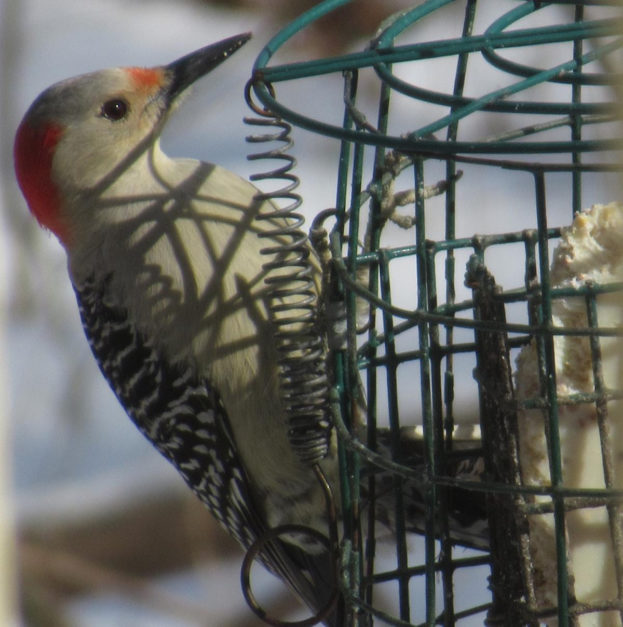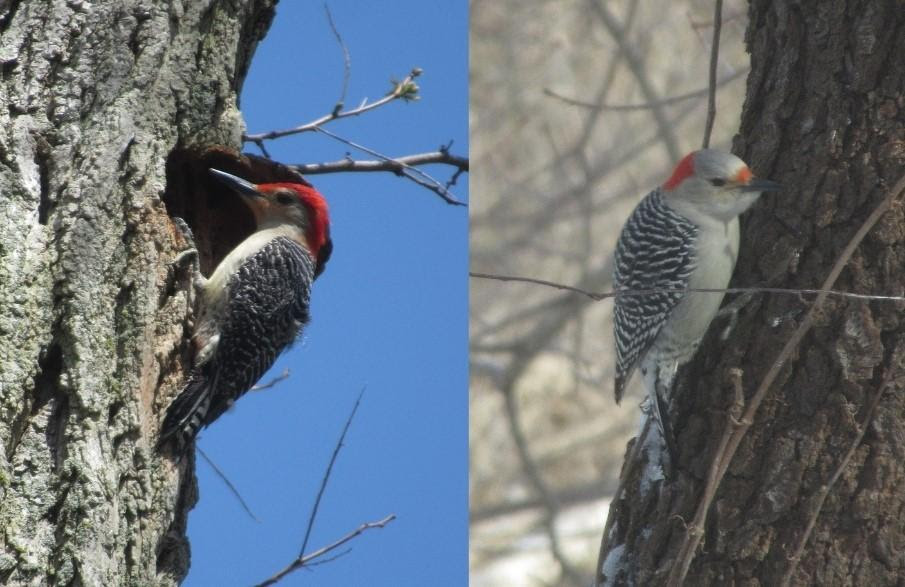![]()
A Bird’s View from Winds Way | Red-bellied Woodpeckers
February 16, 2021
————
a monthly column written by Nancy Gilbert
with photos by Richard Wines
~~~~~~~~~~~~~~~~~~~~

————————-
If you’re like me, you’ve probably wondered how this rather large and conspicuous bird got its name. And certainly many of us have made the mistake of calling it a Red-headed Woodpecker — a somewhat rarer species that is mostly black on the back with big white wing patches but a very red head! Why wasn’t it called the Zebra-backed Woodpecker, or the Barred-backed Woodpecker? Instead, it was named after a spot on its lower belly about the size of a quarter that varies in color from blush to slightly reddish. Unfortunately, this field marking is exceedingly difficult to spot, especially since the bird’s belly is often pressed against a tree trunk or branch.
————————-
The most satisfactory explanation for the misleading name is also rather sad. While ornithology began as a scientific field in the 18th century, it became increasingly popular and specialized during the Victorian era. Until binoculars and other optics were developed that made observation of birds at a distance more viable, birds were studied by collecting eggs and preparing “skins” of dead birds using arsenic or borax. If you held the “skin” of a Red-bellied Woodpecker in your hand and looked at its belly, you would undoubtedly see the reddish splotch, a marking not shared by other woodpecker species.
————————-

——————–
The Red-bellied Woodpecker is easy to spot – it is fairly large at 9 inches in length, strikingly barred on the back with elegant black and white stripes, and unabashedly vocal year-round. And of course both males and females sport beautiful red feathers on the napes of their necks. But look closely – only the male has a bright red cap. The female has a gray cap with a red nape. If you’re lucky enough to spot a juvenile this spring, it will have no red on its head and the barring will appear blurred. At this time of year, you can expect adult birds to be frequent visitors to your feeders. They love suet and sunflower seeds seem only slightly less popular. Not only do they provide color on gray days, but they are fun to watch and listen to as they attempt to commandeer the feeder for themselves and jockey with other birds to establish dominance.
————————-
When out walking, look for Red-bellied Woodpeckers on tree trunks and tree branches. And listen – you may hear one pecking before you see it. Their tail, made stiff by the large shafts in the tail feathers, acts as a brace against the trunk. They will hitch themselves along the trunk or a branch using a combination of hops and pauses and are aided in this effort by the configuration of their toes – two toes face forwards and two backwards. They are prevalent in wooded areas throughout the eastern United States, and in the wild feed on insects, spiders, acorns, nuts, pinecones, fruits and even small vertebrates. A long barbed tongue that can be extended inches beyond the tip of their beak plus spit that is sticky makes them excellent foragers. Red-bellies will cache food in bark crevices and the cracks in trees, but other species of woodpecker are better known for this behavior.
————————-
In late winter and early spring, Red-bellies will become even more vocal and the males will scout out nest sites. These birds are cavity nesters and excavate nests in dead trees and branches. Typically, they will construct a new nest every year but can raise 1 to 3 broods in a breeding season. Often the male will place the new nest beneath the one from the previous year. He will begin the nest and then call and tap softly around the opening to attract a mate. If a female accepts the invitation, she will join the male in tapping and help finish the nest, which consists of a tunnel at least 8 inches long ending in a cup. The 2 to 6 eggs are laid directly on the wood chips produced during construction.
————————-
One of the most fascinating aspects of woodpecker behavior is pecking. They peck to forage for insects and other prey, they peck to build nests, and they drum with their beaks on hard surfaces to communicate. All of this is done with impressive force – up to 15 miles per hour. How can they do this without injuring their brains? Much fascinating research has been done to answer this question. Without going into detail, the brains of Red-bellied Woodpeckers can tolerate more than 60 times the impact that a human brain can tolerate because of its small size and orientation and the extremely short duration of the impact.
————————-
Beginning a hundred years ago, Red-bellies began extending their range north and west from the southeast. The expansion was aided not only by a reliance on a broad and varied diet but also by reforestation, the creation of many more nesting sites in the wake of Dutch elm disease, the proliferation of bird feeders, and by climate change. The northward expansion was most evident in the last 40 years in the northeast. The Red-bellied Woodpecker is thought to be one of the most climate-sensitive species in the eastern US with a population distribution strongly limited by average minimum winter temperatures. While most populations are year-round, birds from the most northern parts of the range may retreat south during cold winters. Many bird species are shifting the locations where they live and where they breed. It is incumbent upon us to figure out what species these are and what kinds of traits they have that will make such shifting possible.
Yes, Red-bellied Woodpeckers can be overly assertive and somewhat pugnacious at your feeders. And it is true that they have been known to predate the eggs and nestlings of other bird species. Nevertheless, they are a beautiful and uniquely engineered part of nature’s complicated and wonderful web. Look and listen for them on your next walk! Leave dead branches on trees for them to nest in, keep your cats indoors, and consider hanging up a suet feeder. The Red-bellies will thank you!
————————-
A Bird’s View from Winds Way is a monthly column by one of our board members and avid birder, Nancy Gilbert — with photos from her husband Richard Wines — on our local birds. Nancy’s columns appear on our blog, so please tune in each month for more from Winds Way.
————————-
— from PLT’s Latest Conservation & Stewardship News / February 16, 2021
———–
www.peconiclandtrust.org
——————
=======================================

AAQ / Resource: Space(s) Landscape Architecture
________________________________________________________________________
